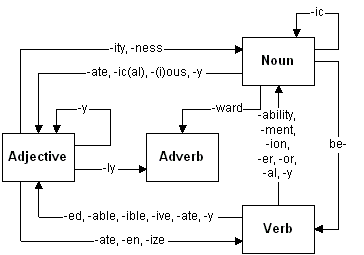

When examined, each essential concept can be found to have a root expression as a noun, a verb, or a descriptive adjective. The expression of a concept begins in one of these three word classes. However, by appending (or removing) appropriate affixes, many instances of these word classes can be transformed into another. The above diagram shows a representative sample of these kinds of transformations.
However, notice that not all of these transformations make sense for all words, even if they are technically feasible (which is also not always the case). For example, the adjective blue does not lend itself well to suffixes like -ity (blueity), -ize (blueize), or even -ly (bluely). So, some potential word derivations are simply non-sense. Others may have some semblance of meaning, but only in a prosaic or poetic context, not in a computational one.
Where a set of semantically related words does exist, the underlying essential concept can be said to be independent of any specific word class. Alternatively, we could say that all three word classes (noun, verb, and adjective) taken together provide the fullest expression of an essential concept.
From an analytic viewpoint, it is fortunate that these morphological transformations are reversible. This allows us to systematically discover a range of possible variations and alternatives for expressing a particular concept. We can then substitute the variant or alternate for the original concept when needed, with appropriate syntactic transformations.